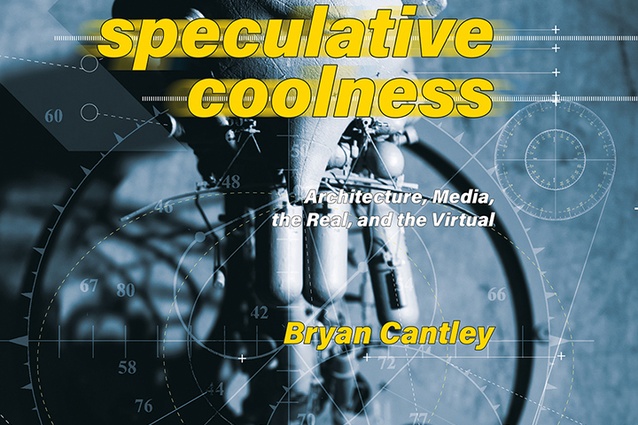[ad_1]
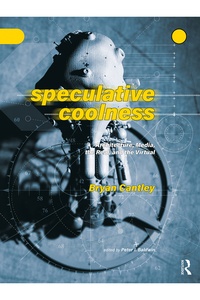
For those readers who have been unable to acquire Cantley’s first book, Mechudzu: New Rhetorics for Architecture — now long out of print — Speculative Coolness will be a revelation.
Through an impressively displayed selection of Cantley’s work, it critically explores the liminal realm that separates — and integrates — the digital and analogue voices of architectural representation. In the foreword, Neil Spiller declares that Cantley is “finding new architectures inconceivable to the binary logics of computers and often creating works of interstitial beauty — between art and architecture. Such pursuits expand architectural discourse, re-examine what constitutes architecture and pull the turgid, everyday, normative world of building into new universes”.
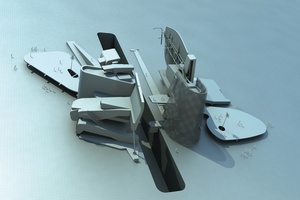
Model assistant/ rendering by Joey Dhindsa.
Speculative Coolness repositions architectural praxis by blending, overlaying, fragmenting and compounding the second, third and fourth dimensions: surface, space and time. Within each of Cantley’s drawings, our eyes are ‘drawn’ along sight/site lines that shift scales and temporal conditions, reorienting while recontextualising symbols, notations and mnemonic devices. Our normative perception of an architectural drawing loses its footing; we are forced to reconceptualise architectural representation — and, indeed, the architectural discipline — as a convergence of historical, cultural, political, allegorical and temporal domains. Pentimento and palimpsest converge; smudged graphite meets pixel; compositional torque establishes rotational shifts; and the static becomes dynamic.
Throughout Speculative Coolness, Cantley’s drawings and models are interspersed with essays by such architectural luminaires as Rana Abudayyeh, Peter J Baldwin, Helen Castle, Nat Chard, Dora Epstein Jones, Wes Jones, Thom Mayne, Bob Sheil, Neil Spiller and Martin Summers. The reader moves slowly (at first) through the alluring codex, capturing clues on one page that inform another, reading intently and with deliberation, and then shifting velocity, flipping through a few pages, only to be brought to a halt by yet another astounding drawing or an essay that demands critical reflection.
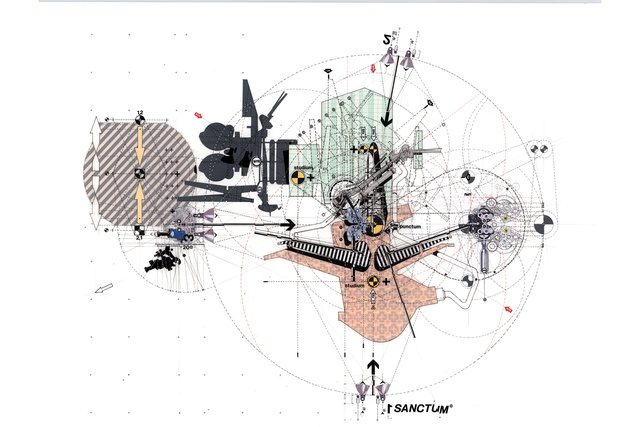
Drawing by Bryan Cantley.
In Cantley’s drawing ‘Camera Noxoculo: The manifest of the Sanctum(etrics)’, architecture is caught in the act of literally drawing itself as a speculative representation. At the same time, the architecture — a tomb for Cantley — is itself in its death throes. Cameras and lights capture the event, voyeuristically and opportunistically. In ‘Social AMP: Full network conflict diagram 003’, the architectural intervention — a societal ‘observatory’ — appears to have left frenzied scratches upon the surface of the drafting board, residual traces left behind by acts of frenetic temporal recognisance. ‘Social AMP 002: Truth can be a divisionary tactic’ is yet another iteration of the same project, evidencing that, even as his drawings traverse thresholds between the real and unreal, Cantley can reposition them as realisable constructs.
Cantley narrates his tale using the voice of the architect, unveiling clues that perhaps only an architect can be expected to interpret and understand. Notation devices and graphic interfaces that are common on architectural construction drawings — scale bars, elevation numbers, registration marks, dashed lines, projected geometries — become realigned to unveil strategically a work of architecture hovering within a multidimensional metaverse. The architect, trained in these notation devices, will recognise the temporal and spatial implications of their unexpected shifts and realignments.
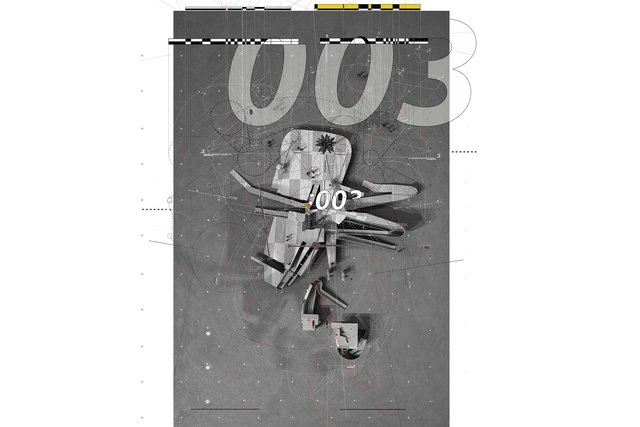
Image by Kevin F. O’Donnell.
This repositioning of notational language is not restricted to the speculative drawings alone. The book itself is its own temporal and intertextual speculative representation. Reappropriated punctuation marks in Cantley’s writing take on the roles of the architectural notation devices that populate his drawings. Words become parasitically re-inhabited by unexpected parentheses, superscripts, brackets and capitalisations. The resulting portmanteaus create temporal and intertextual convergences of their own, revealing that his “text is a parallel to the nature of the work — these fabricated histories, projections and rogue inquiries are the sites, conceptual and physical, of both the projects and the book itself”.
The afterword by Thom Mayne is perhaps the most enlightening of all. Mayne situates Cantley’s work at the forefront of the dilemma that confronts our modern age, observing that, in Cantley’s drawings, “the classical devices of architectural representation — appear together in dialectical tension, generating new coherencies that reject the prescriptive intentionality of those drawing types. Juxtaposing the analogue and the digital, [Cantley’s] manual techniques resurface as the only tool capable of errors that are deft and dirty enough to confound the programmatic rationality of the digital environment.
[ad_2]
Source link

